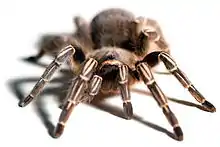Aphonopelma seemanni
Aphonopelma seemanni, the Costa Rican zebra tarantula, also known as the striped-knee tarantula, is a species of tarantula inhabiting most of western Costa Rica and other parts of Central America, such as Honduras and Nicaragua, and possibly Guatemala.[1] It is usually black with white stripes near the leg joints, but a brown color form also exists for the spider.[2]
| Costa Rican zebra tarantula | |
|---|---|
 | |
| Scientific classification | |
| Kingdom: | Animalia |
| Phylum: | Arthropoda |
| Subphylum: | Chelicerata |
| Class: | Arachnida |
| Order: | Araneae |
| Infraorder: | Mygalomorphae |
| Family: | Theraphosidae |
| Genus: | Aphonopelma |
| Species: | A. seemanni |
| Binomial name | |
| Aphonopelma seemanni (F. O. P-Cambridge, 1897) | |
 | |
| Synonyms | |
|
Eurypelma seemanni | |
Zebra tarantulas are deep-burrowing spiders. They live in open, semiarid scrublands, and are often found in large aggregations. Their deep burrows keep the temperature below the highest daytime temperatures, and retain humidity. Conversely, as temperatures drop at night, the burrows buffer away from the lowest temperatures.[3]
Zebra tarantulas can grow to about 10–13 cm including leg span. Females can live up to 20 years. Males, however, tend to live a much shorter life – up to five years, with about a single year of maturity. In the wild, they eat a wide variety of insects such as grasshoppers and cockroaches. In captivity, they eat crickets.
References
- "A-seemanni-care-sheet". www.mikebasictarantula.com. Retrieved 2020-07-28.
- Ian (2017-02-15). "Costa Rican Zebra Tarantula (Aphonopelma seemanni)". Tarantula Friendly. Retrieved 2020-07-28.
- Natural History Museum Bern. "NMBE - World Spider Catalog". wsc.nmbe.ch. Retrieved 2020-07-28.
- Platnick, Norman I. (2008): World Spider Catalog, version 8.5. American Museum of Natural History.